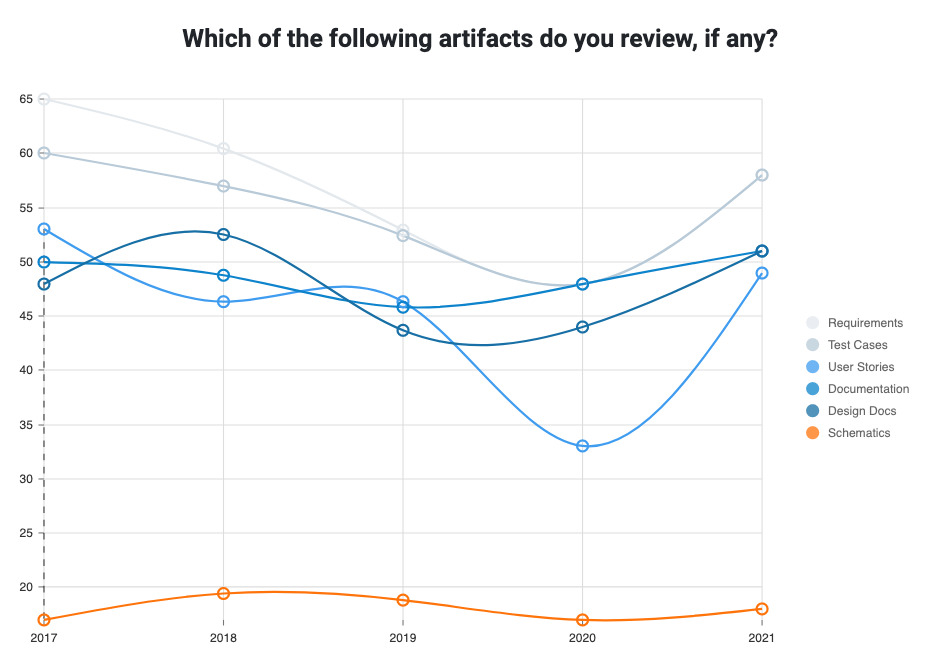Quality software starts with code review, but quality doesn’t begin and end with code. Documents and artifacts need proper attention to make sure nothing slips through the cracks. To ensure quality software, it's essential to review the software artifacts left behind from the code review process.
If code review is the unglamorous task of eating your vegetables, artifact review might as well be getting your 10,000 steps in. Both can be downright boring, but they're good for you. With consistent performance, they'll benefit your (software) health in the long run.
Which artifacts should you review? If you visit our State of Software Quality | Code Review 2021 microsite, you’ll see that artifact review encompasses a wide range of artifacts. This may include requirements (the most common), test cases, user stories, design docs, and more.

Line chart of which artifacts survey responders review.
Sourced from the State of Software Quality | Code Review 2021
As the chart shows, review has experienced an increase in all artifacts apart from schematics, which has stayed relatively constant. The dramatic increase specifically in requirements comes as no surprise, since respondents stated for the third year in a row that “changing requirements” is their biggest challenge to delivering on-time releases.
Why are artifacts, such as requirements, so impactful and critical? Clear guidelines are necessary for quality review and, in turn, quality code. The pace of delivery has also increased across all software disciplines, which requires constant re-examining and redefining when it comes to review requirements to ensure on-time delivery.
Many other factors play a role, including geographically diverse teams, remote work, and industry trends. Teams engaging in code and document review need a tool that can simultaneously perform artifact review, so important factors (like requirements) aren't forgotten.
What to evaluate in a review platform
In a perfect world, a single platform performs the big three tasks: code, document, and artifact review. An all-in-one peer-review platform covers all the bases and makes sure nothing is lost during the review process.
Review process varies by companies and even between teams. Customizable peer-review workflows, based on team and organization needs, help establish a clear audit trail filled with proper attaching and tracking verification of artifacts. This enables better accuracy, minimizes errors, and streamlines the review process. Your artifact review process will verify and complete your requirements from the start, with an audit trail to reference. The peer-review tool you choose must check this box to accomplish all of the above and maintain accountability within your team.
In addition, developers should be able to write and maintain quality software application requirements. Accurate requirements translate into fewer flaws in the code, cleaner tests, and a savings of time and energy when organizations ship software with fewer defects. It's also helpful to have versions which leave a useful record throughout the process.
Where Collaborator comes in
Collaborator was designed to drive meaningful collaboration while simultaneously establishing a painless audit trail. It’s a customized solution for both document and source code review that lets you define a best practice review process for the SDLC. Whether that process is to have a certain number of sign-offs on the review, or ensure certain members from each discipline are part of it, or any other configuration, it’s completely configurable. And it’s extensible, integrating with external solutions such as Jira.
Since Collaborator handles both document and source code review, many organizations choose it as their SDLC review platform of choice. These organizations optimize their process with one tool that does code, document, and artifact review while supporting multiple teams and connecting multiple tools.
Collaborator also helps from an administrative perspective. If teams don't have to learn how to configure, or have the overhead of administering two tools, the environment is simpler. Benefits to simpler tooling include working with one vendor and standardizing one process across the organization.
Finally, for many teams, reporting from reviews is key to defining success. Are they successful within the context of their peer reviews? Are they finding or releasing fewer defects? Are they capturing the data they need for compliance? Success can be defined in many ways, and Collaborator allows flexibility for organizations to manage their reporting needs.
Resources for further learning
Artifact review is essential to proper code review and a thorough peer-review process. A tool that performs up to a team's standards, streamlines their processes, acts as a data repository, and establishes an audit trail further enhances team collaboration and increases team performance.
To learn more, view our library of resources or attend one of our On-Demand Webinars which gives more details of the Collaborator solution, and shows how you can improve quality through document review.
You can also read the latest research and discover what your peers think about code, document, and artifact review by checking out the State of Software Quality | Code Review 2021 survey report. Close to 800 software professionals participated in the study, providing insights into document and code review, frequency, tools, and code quality.
If you’re ready to implement a collaborative peer-review tool and discuss how Collaborator can help your organization, please contact sales below.